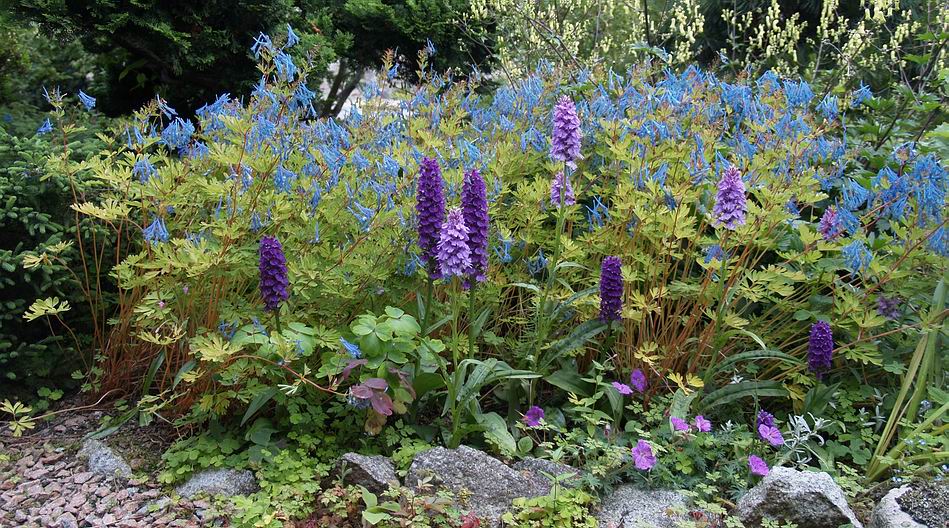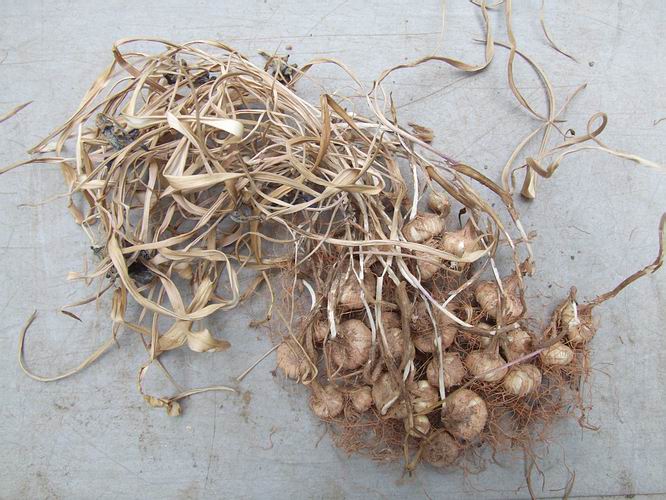|
BULB LOG 29 --- 16th July 08

Verity in drive
This is Verity, our little car, in the drive: Top Gear, the BBC car programme describes our car as very un-cool and I suspect that we are even more un-cool because we have personalised her with a name but then all the Top Gear people are petrol-heads and I am happy as I am.

Dianthus and Geranium in drive
However it is not the car I wanted to show you but the planting in the gravel areas of the drive where Geranium sanguineum and Dianthus deltoides provide the colour for the summer months.

Yellow bulb
As this is the drive that I park Verity on I have to make sure that all plants are short enough not to be damaged by the car as she goes in and out. Over recent years I have scattered all sorts of bulb seeds there and I have no idea what this little yellow bulb is so if you have any suggestions I would be pleased to hear them.

Verity and Corydalis 'Craigton Blue'
The very observant among you will perhaps have noticed that Verity is the same colour as Corydalis 'Craigton Blue' growing by our front door.

Dactylorhiza and Corydalis ' Craigton Blue'
I showed you pictures of this area of 'Craigton Blue' in bulb log 24 ago and it is still looking beautiful and the scent of honey still welcomes people to our door and now some Dactylorhiza are providing a nice contrast of colour.

West drive
Cars are not often in the other drive so this is the one where we have sowed most of the bulbous subjects such as Fritillaria, Erythronium, Crocus, etc. that I showed earlier in the year. The Fritillaria meleagris seed pods have all just matured and we have been scattering the seeds along the length of the gravel area. It is amazing how many plants we have established in these gravelled sections of the drives over the years and all just by scattering the seeds.

Narcissus 'Craigton Clumper'
Back to the big task of re-potting and I am still picking pots at random to see how things have done especially since, if you remember, I changed my compost mix last year. Having run out of my supply of loam my mix became 2 parts sharp sand, 2 parts 6mm grit and 1 part leaf mould and I must say that I am pleased with the results. This is a pot of one of my own selections from seed raised Narcissus romieuxii - I call it 'Craigton Clumper'. As you can see I cram as many as I can into a pot often adding a few bulbs onto a second layer if I have only a few left.

Narcissus 'Craigton Clumper' bulbs
Now even I would be hard pushed to get all these bulbs back into the same pot and still leave some space for expansion.

'Craigton Clumper' goes up a pot size
So yet again I have had to move up a pot size to accommodate the increasing number of bulbs. For a long time I have put out a list of the surplus bulbs after I have finished repotting but this year I have decided not to do this for a few reasons. One is it takes a lot of time to send out all the packages, another is that I want to expand many of the plantings of erythroniums and I also want to try more of the bulbs which I have only grown under glass up until now, outside in the open garden.

Soft Narcissus bulbs
One of the valuable things about re-potting every year is it gives you the chance to give the bulbs a health check. The firmness of a bulb is usually a good sign and any bulbs that feel slightly soft to the touch should be regarded with suspicion. The bulbs above all showed either visual signs of a possible problem or felt soft to the touch. Cutting them in half either confirmed the problem or proved that they were healthy - or are they? Just look at the very bottom of the second from the left section in the lower picture and you can just see the early signs of a basal plate rot infection and my advice is to discard these or at least grow them on separately.

Tecophilaea cyanocrocus corms
I am always pleased to see a healthy pot of Tecophilaea cyanocrocus corms and these are looking healthy but I have had better sized offsets in some years.

Tecophilaea cyanocrocus corms cleaned and potted
Once cleaned up I replace the corms back into the same pot and this time there is plenty of room for expansion over the next few years. Notice they are planted just below the half way level of this pot.

Roscoea tibetica
I showed some of our Roscoeas a week or two back and here is another wee gem; R. tibetica.

Roscoea tibetica pot
It is better if I pull back and give you the picture with the pot as this reveals the true size of this compact plant, ideal for a raised bed or a trough.

Roscoea Kew Beauty seedlings
Two different seedlings raised from the Kew Beauty form of Roscoea cautleyoides (which is perhaps a hybrid with R. humeana).

Roscoea humeana
One of the things that make Roscoea humeana such a good plant is that once you are over the excitement of the first few flowers appearing the plant just goes on throwing up more and more for a good few weeks.

Me Lily and hemlock
I am always willing to let plants have their space in the garden when possible especially when they are interesting as this Hemlock - said to be the source of the poison that killed Socrates. Conium maculatum is one of the many interesting plants that have germinated from our bird seed mixes and having enjoyed it for some time now I decided it was best to get rid of it before it set seed and spread itself all over.
^ back to the top ^
|

